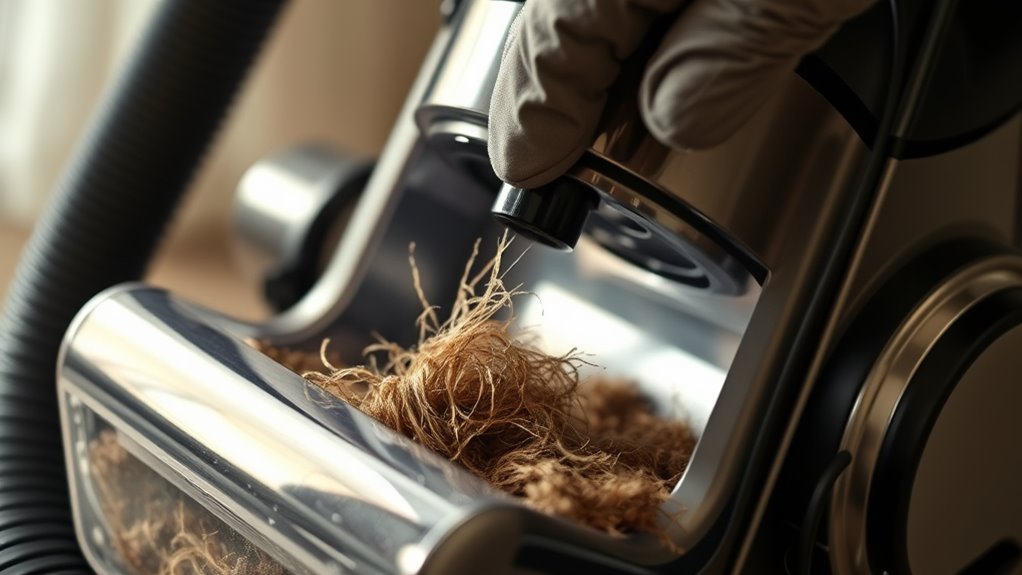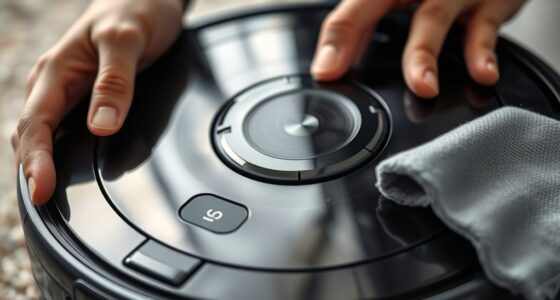When handling clogs in your upright vacuum, first unplug it and detach the hose for inspection. Use a flashlight to spot any debris. If you find a blockage, gently push it out with a flexible tool, being careful not to damage the hose. Also, check the brush roll for tangles and clean or replace filters as needed. Regular maintenance is key to preventing further clogs. Stick around, and you’ll discover more tips for ideal vacuum performance.
Key Takeaways
- Unplug the vacuum and detach the hose to inspect for visible clogs using a flashlight.
- Use a long, flexible tool to gently push out debris from the hose.
- Regularly check and clean the brush roll, removing tangled hair or fibers.
- Inspect and clean or replace filters to maintain optimal suction power.
- Empty the dust container and replace vacuum bags regularly to prevent clogs.

When you notice your upright vacuum isn’t picking up dirt like it used to, it’s often due to a clog somewhere in the system. This issue can be frustrating, but with a little troubleshooting, you can restore your vacuum’s performance. First, let’s understand that clogs are common, especially if you’ve been using your vacuum regularly without proper vacuum maintenance. Dust, hair, and debris can accumulate in various parts, hindering airflow and suction.
To start troubleshooting clogs, unplug your vacuum and inspect the hose. Detach it from the main body if possible, and look for any visible obstructions. A flashlight can help you see deeper into the hose. If you spot a blockage, use a long, flexible tool, like a broom handle, to gently push the debris out. Be careful not to damage the hose while doing this. If the clog is stubborn, consider using a wet-dry vacuum to suck it out.
Unplug your vacuum, inspect the hose for clogs, and use a flexible tool to clear any blockages.
Next, check the brush roll. Hair and fibers often wrap around it, preventing it from spinning effectively. Turn your vacuum over and examine the brush roll. If you find tangled hair, use scissors to cut it away carefully. After you’ve cleared the brush, rotate it to ensure it moves freely. Regularly cleaning the brush roll is an essential part of vacuum maintenance that can help avoid clogs in the future.
Don’t forget to examine the filter. A dirty or clogged filter can greatly reduce suction power. Most upright vacuums have a removable filter that can be washed or replaced. Refer to your vacuum’s user manual for specific instructions on how to clean or replace the filter. Remember, a clean filter not only helps with suction but also prolongs the life of your vacuum.
Finally, check the dust container or bag. If it’s full, your vacuum won’t work efficiently. Empty the dust container or replace the bag as needed. Make this a regular part of your vacuum maintenance routine to prevent clogs from forming.
Once you’ve completed these steps, reassemble your vacuum and give it a test run. You should notice a significant improvement in suction. If your vacuum still isn’t performing well, it might be time to consult a professional. Regular vacuum maintenance and proactive troubleshooting clogs can keep your upright vacuum in top shape for years to come. Additionally, automation technologies can be a game-changer for home cleaning routines, enhancing efficiency and effectiveness.
Frequently Asked Questions
How Can I Prevent Clogs in My Vacuum?
To prevent clogs in your vacuum, focus on airflow optimization and brush roller maintenance. Regularly check and clean the brush roller to guarantee it’s free from hair and debris. Make sure the vacuum bag or bin is emptied frequently to maintain strong suction. Inspect the hose for blockages and clear them out. Keeping these areas in top shape will help you avoid clogs and keep your vacuum running efficiently.
What Tools Do I Need to Clear a Clog?
To clear a clog, you need a few handy tools, like a screwdriver, a flexible cleaning brush, and a pair of scissors. Think of these tools as your trusty sidekicks in the quest for vacuum maintenance. First, unplug the vacuum and disassemble it according to troubleshooting tips. Use the brush to dislodge debris and scissors to cut any tangled hair. With these tools, you’ll tackle clogs like a pro!
Are There Specific Materials That Cause More Clogs?
Yes, certain types of debris tend to cause more clogs in vacuums. Common clog causes include hair, especially pet hair, and larger items like small toys or paper. Dust bunnies and carpet fibers can also build up and create blockages. To prevent these issues, regularly check your vacuum’s hose and filters, and try to pick up larger debris manually before vacuuming. Keeping your vacuum clean helps maintain peak performance.
How Often Should I Check for Clogs?
You should check for clogs at least once a month, especially if you use your vacuum frequently. Regular inspections help you catch air filter maintenance issues early and prevent brush roller problems. If you notice a drop in suction or hear unusual sounds, check for clogs immediately. Keeping an eye on these aspects guarantees your vacuum runs efficiently, prolonging its life and maintaining ideal cleaning performance.
Can a Clogged Vacuum Damage the Motor?
Yes, a clogged vacuum can definitely damage the motor. When you neglect vacuum maintenance, debris builds up and restricts airflow, causing the motor to overheat. If you let this continue, you might find yourself facing costly repairs or a complete motor replacement. To guarantee your vacuum runs smoothly, regularly check for clogs and clean your filters. Keeping up with maintenance not only protects the motor but also extends your vacuum’s lifespan.
Conclusion
Just like a river needs to flow freely to nourish the land, your upright vacuum thrives when it’s free of clogs. By regularly checking and clearing any blockages, you make sure your cleaning companion works at its best, transforming your home into a haven. So, take a moment to tend to your vacuum as you would a garden; with a little care, it’ll continue to bloom, leaving your space fresh and inviting. Keep the flow going!









